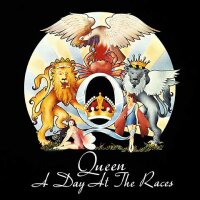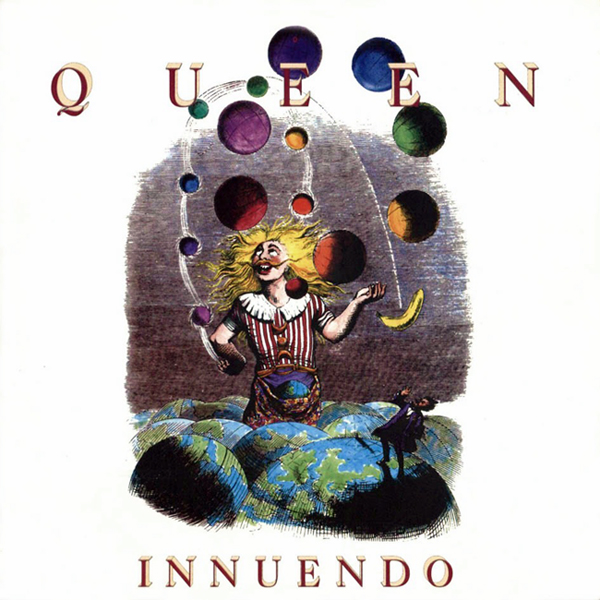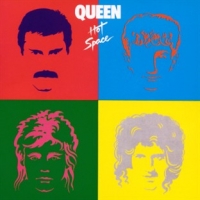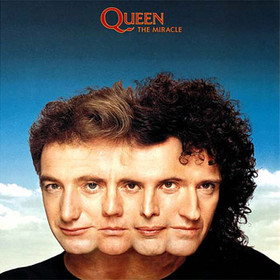01-31-1977 – Circus Magazine
Queen’s own tale of success
by Wesley Strick
‘A Day At The Races’ is a self-made masterpiece “The new Queen album is called A Day At The Races,” laughs lead singer Freddie Mercury, “and not Horse Feathers!”
It was some weeks back, and Europe’s biggest rock band had four months’ studio time behind them, and two weeks ahead. “It feels like we’ve been working forever,” Freddie sighs, “and I’ll be glad to see the end of it. I think we all will, although everything’s been going fine. We’ve even got release dates set up,” he adds, optimistically.
Later, sitting comfortably on the finished product, Queen’s animated lead singer takes time out to talk about the carefully delayed album. A Day At The Races (Asylum), Queen’s fifth, is the band’s first self-produced record. “We finally got that organized,” Freddie nods, to explain the absence of veteran Queen producer Roy Thomas Baker: “We just felt that, for this one, we needed a bit of a change. We were quite confident in doing it ourselves. The other albums we really co-produced, actually we always took a very keen interest.”
“It was all very amicable,” drummer Roger Taylor is quick to explain. “Roy’s been in and out of the country. He’s heard some rough mixes. Who knows? Maybe he’ll be back producing the next one! It’s been tremendous pressure recording this album.” Mercury, meanwhile, is quite happy with Queen’s first attempt at studio self-sufficiency. “I think it turned out for the better,” he insists. “Taking more responsibility has been good for us. Roy’s been great, but it’s a progression. really – another step in our career. We simply felt that it was now or never.”
Queen fiends needn’t despair, however. “There are definitely different sounds and a few surprises on the album” Freddie promises, “but we’ve still maintained the basic Queen sound.” A Day At The Races features four songs from Mercury, four from guitar-phenomenon Brian May, and one each from Taylor and bassist John Deacon. “I feel this time that we’ve got quite a few strong singles,” says Freddie. “It was a very hard choice, to be honest. Picking the first single is a matter of taste. We settled on `Somebody To Love’ to start things rolling. It’s one of my tracks,” Mercury adds, modestly.
” `Somebody To Love’ is Aretha Franklin-influenced,” Taylor says. “Freddie’s very much into that. We tried to keep the track in a loose, gospel-type feel. I think it’s the loosest track we’ve ever done.”
“It’s new, it’s slightly different,” Freddie agrees “but it still sounds like the Queen that used to be. A Day At The Races is definitely a follow-up to A Night At The Opera. Hence the title. We learned a lot from A Night At The Opera about studio technique.” “This time out we missed Roy’s cheerfulness,” Taylor says. “He contributed a lot technically, and we’ve capitalized on it.”
Each time we go into the studios, it gets that much more difficult,” Freddie explains, “because we’re trying to progress, to write songs that sound different from the past. The first album is easy, because you’ve always got a lot in your head that you’re anxious to put down. As the albums go by, you think, `They’ll say I’m repeating a formula.’ I’m very conscious of that.”
Taylor confirms their constant testing: “We took a break in the midst of it to play three gigs. It was great to get away from the studio for a bit, and it was great playing live, again-that’s a much more immediate satisfaction.”
“It was difficult trying to maintain the Queen idiom,” Mercury elaborates, “and, at the same time, come up with songs that were different and more interesting.” Freddie Mercury offers his own track-by-track rundown on Races:
“We start off with a track from Brian called `Tie Your Mother Down’ which we’ve recently put in the live act. In fact, we played it at Hyde Park before we recorded it. I was able to come to grips with the song in front of an audience before I had to cut the vocal. Being a very raucous track, it worked well for me.
” `You Take My Breath Away’ is a slow ballad with a new twist. That’s another track I did at Hyde Park, with just me on the piano. It was very nerve-wracking playing all by myself in front of 200,000 people. I didn’t think my voice would come through,” Freddie jokes, half-serious, “It’s a very emotional, laid-back number.
” `Long Away’ is a twelve-string thing written by Brian…very interesting harmonies.
” `The Millionaire Waltz’ is quite outlandish, really. It’s the kind of track I like to put on every album,” Freddie teases. “Something way outside Queen’s format.”
“It’s comparable to `Bohemian Rhapsody’,” Roger Taylor explains, “in the sense that it’s an arranged, intricate number. There are several time-signature changes,” the drummer adds, “‘though not quite so many vocal overdubs.”
“Brian has orchestrated it fully with guitars,” Freddie says, “like he’s never done before. He goes from tubas to piccolos to cellos. It’s taken weeks. Brian’s very finicky. Anyway, this track is something that Queen has never done before-a Strauss waltz!
” `You And I’ is John Deacon’s track. It’s very John Deacon, with more raucous guitars. After I’d done the vocals, John put all these guitars in, and the mood has changed. I think it’s his strongest song to date.”
Unlike the concept-ized Queen II with its Side White and Side Black, A Day At The Races plays, in Freddie’s words, “as a unit. Side Two opens with `Somebody To Love,’ the single. We’re not going to settle for less than Number One in America. We were a bit disappointed in `Rhapsody’.” Disappointed? “I suppose we’re spoiled,” Freddie concedes, light-hearted. ” `Rhapsody’ was a strong song, and a mammoth hit on Continent. This time, we won’t be second best.
” `White Man’ is the B side. It’s Brian’s song, a very bluesy track. Gave me the opportunity to do raucous vocals. I think it’ll be a great stage number.
“‘Good Old-Fashioned Loverboy’ is one of my vaudeville numbers. I always do a vaudeville track, ‘though `Loverboy’ is more straightforward than `Seaside Rendezvous’, for instance. It’s quite simple piano-vocals with a catchy beat; the album needs it to sort of ease off.
” `Drowse’ is a very interesting song of Roger’s. Roger is very rock and roll. It’s got great slide guitar from Brian and Roger’s done octave vocals. It’s a very hum-able tune, actually, I sing it all the time.
“The album ends with a Japanese thing, a track from Brian called `Teo Torriatte,’ which means `let us cling together.’ It’s a very emotional track, one of his best. Brian plays harmonium and some lovely guitar. It’s a nice song to close the side.”
To graphically emphasize Races’ connection with its predecessor, the new LP features inverse-Opera artwork, a black motif with a subtly revised insignia. Freddie envisions a repackaged re-release of the two albums “at some future date. But we’ll have to get out of this Marx Brothers thing sooner or later.”
Pre-package or not, Roger Taylor considers the new album a distinct improvement over A Night At The Opera. “The new songs are stronger,” he asserts, “and the playing is quite possibly better. The writing’s better, too.”
For Taylor, A Day At The Races represents “a step ahead of our previous work. We tried to avoid over complication, sterility-we tried to get a more basic feel in.”
Is Queen living down its reputation for studio fussiness? “Not at all,” Taylor answers, “I think it’s good to be fussy. You might as well make it as good as you can if you’ve got all the studio devices at your command. As long as the end result isn’t clinical; as long as you maintain the feel of the music.”
If Mercury and May have loosened up in the studio, they’ve failed to tighten up their legendary recording budget. Endless vocal and guitar overdubs account for the five-month sessions and staggering expense. “I’m afraid this one cost as much as the last one,” Taylor admits, chagrined.
According to the British press, A Night At The Opera came in at forty thousand pounds.
Freddie Mercury, drained and despairing after months of painstaking overdubs, has a bright idea. “I really feel that, on the next album, we’re going to get it orchestrated by an orchestra,” he says. “I think we’ve really done as much as we can with guitars.”
Does Brian concur? “I think he does,” Freddie chuckles. “We always did it ourselves, and it was rewarding. But now, we’ve done it, and it’s time to move on.” Is Queen still staunchly opposed to synthesizers? “We’ve built up a terrible aversion to them,” Freddie concedes, “but you never know. To me, Brian always sounds better than a synthesizer.”
Finally, does Queen reign supreme in the U.K.?
“That’s an awkward question,” Roger laughs. “I’m thinking about it.” Roger’s synapses silently arrange the electrical impulses of two words: Led and Zeppelin. “Yes, I suppose we are,” he concludes. “It feels good in terms of radio response and fan letters, that sort of thing. In the studio, nothing feels quite real. You lose contact with things on the street. We don’t see much daylight at all.”
Beginning mid-January, the band should be seeing plenty of daylight. “I’ve just been handed a list of tour dates,” Freddie says, “and, oh my god, it’s going to be two-and-a-half months in the States. I’m just hoping my voice will hold out.”
Will the ultra-theatrical Queen mount its American onslaught with a whole new show? “A whole new show?” Freddie chuckles. “Bloody hell yes!”




